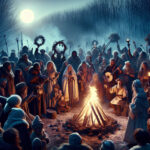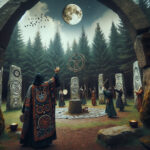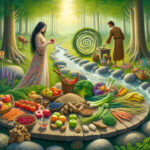The Christmas holiday season is a time of joy, celebration, and family gatherings. While many people may associate Christmas with the Christian holiday, there is also a Pagan version of Christmas that is celebrated by many people around the world. This article will explore what the Pagan version of Christmas is, how it is celebrated, and the spiritual beliefs that are associated with it.
Pagan Christmas is the celebration of Christmas that is based on a pre-Christian holiday tradition. It is sometimes referred to as Yule, Yuletide, or Winter Solstice. Pagan Christmas is celebrated by some modern Pagans and non-Pagans who wish to celebrate the season without all the commercialism of modern Christmas.
What Is Pagan Christmas?
Pagan Christmas is a holiday that celebrates the winter solstice. It is an ancient holiday that predates Christianity and can be traced back to pre-Christian cultures and traditions. The holiday was originally celebrated as a way to commemorate the longest night of the year and the return of the light and the sun.
Pagan Christmas is celebrated on the winter solstice, which usually falls between December 21st and 23rd. On this day, Pagans celebrate the longest night of the year and the beginning of the sun’s return to the Northern Hemisphere.
Pagan Christmas is celebrated in many different ways, but the main focus is on celebrating the solstice and the return of the sun. Many Pagans will decorate their homes with festive decorations and light a yule log to honor the sun. They will also gather together to exchange gifts and share stories and feasts. Some Pagans may also practice rituals and spells that are meant to bring good luck and prosperity in the coming year.
Symbols of Pagan Christmas
Pagan Christmas is often associated with a variety of symbols and traditions. Some of the most common symbols include:
• Yule Log: A large log that is burned in honor of the return of the sun.
• Yule Tree: A decorated evergreen tree that is meant to represent the eternal life of the sun.
• Holly: A symbol of rebirth and renewal, holly is often used to decorate homes during Pagan Christmas.
• Mistletoe: A symbol of fertility and abundance, mistletoe is often used to decorate homes and exchanged as a gift.
• Masks: Masks are often worn during Pagan Christmas celebrations to represent the changing of the seasons and the cycle of life.
• Wreaths: Wreaths are often hung on doors and windows to symbolize the cycle of life and bring luck and prosperity into the home.
• Candles: Candles are used to bring light and joy into the home during Pagan Christmas.
• Gifts: Gifts are exchanged as a sign of love and appreciation.
• Feasting: Feasting is a common tradition during Pagan Christmas, with a variety of traditional dishes being served.
• Music and Dance: Music and dance are often part of the festivities, with traditional songs and dances being performed.
Conclusion
Pagan Christmas is an ancient holiday that predates Christianity and is celebrated by modern Pagans and non-Pagans alike. The holiday is celebrated on the winter solstice and is marked by a variety of symbols and traditions. From the burning of the yule log to the exchange of gifts, Pagan Christmas is a time of celebration and renewal.
In conclusion, it is clear that the Pagan version of Christmas is an important part of the holiday season. It is a time to celebrate the winter solstice, the longest night of the year, and to recognize the importance of nature in our lives. It is also a time to come together with family and friends to celebrate the end of the old year and the beginning of a new one. It is a time to reflect on the past and to look forward to the future with hope and optimism. Ultimately, the Pagan version of Christmas is a celebration of life, of nature, and of the human spirit.





